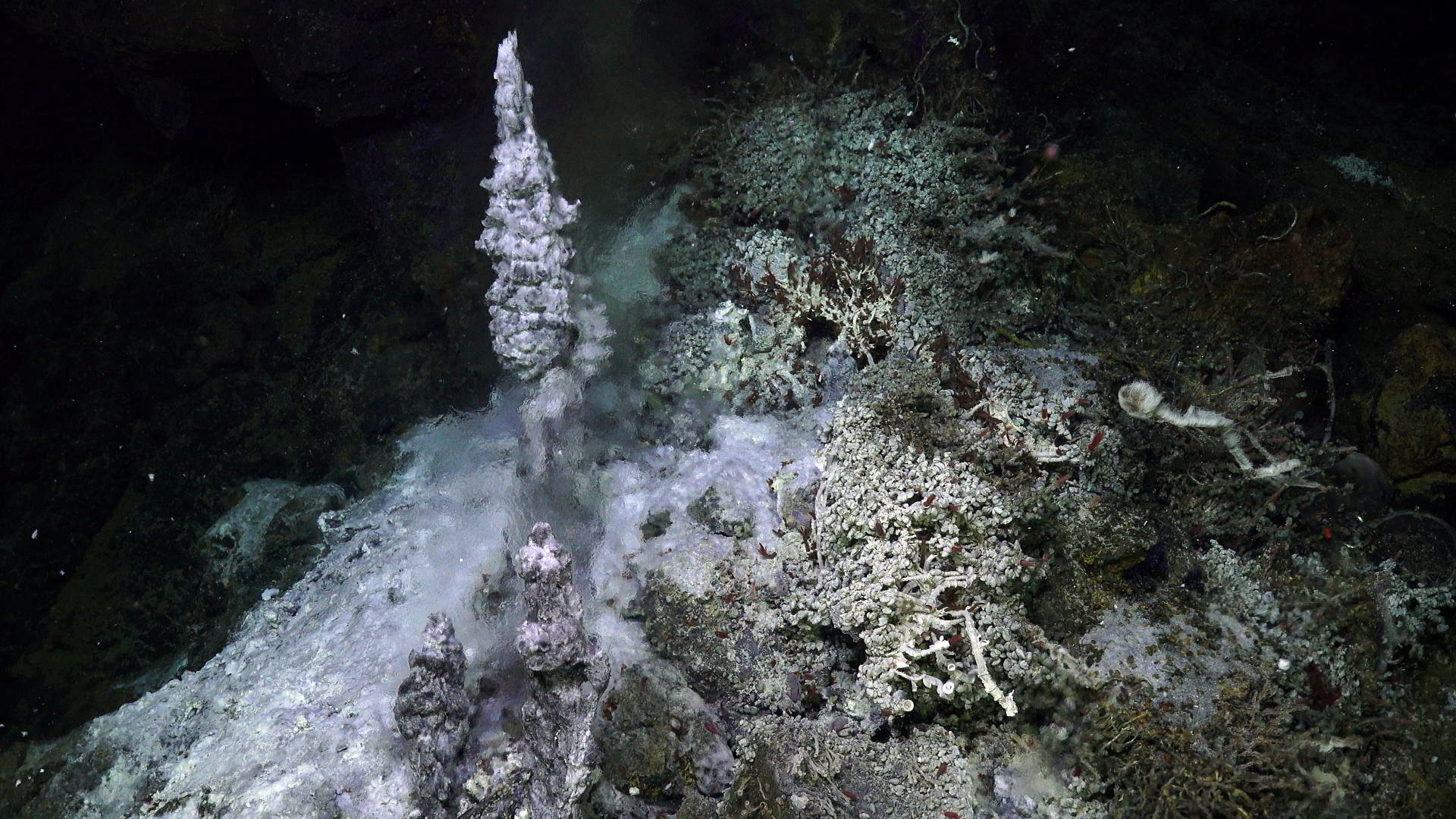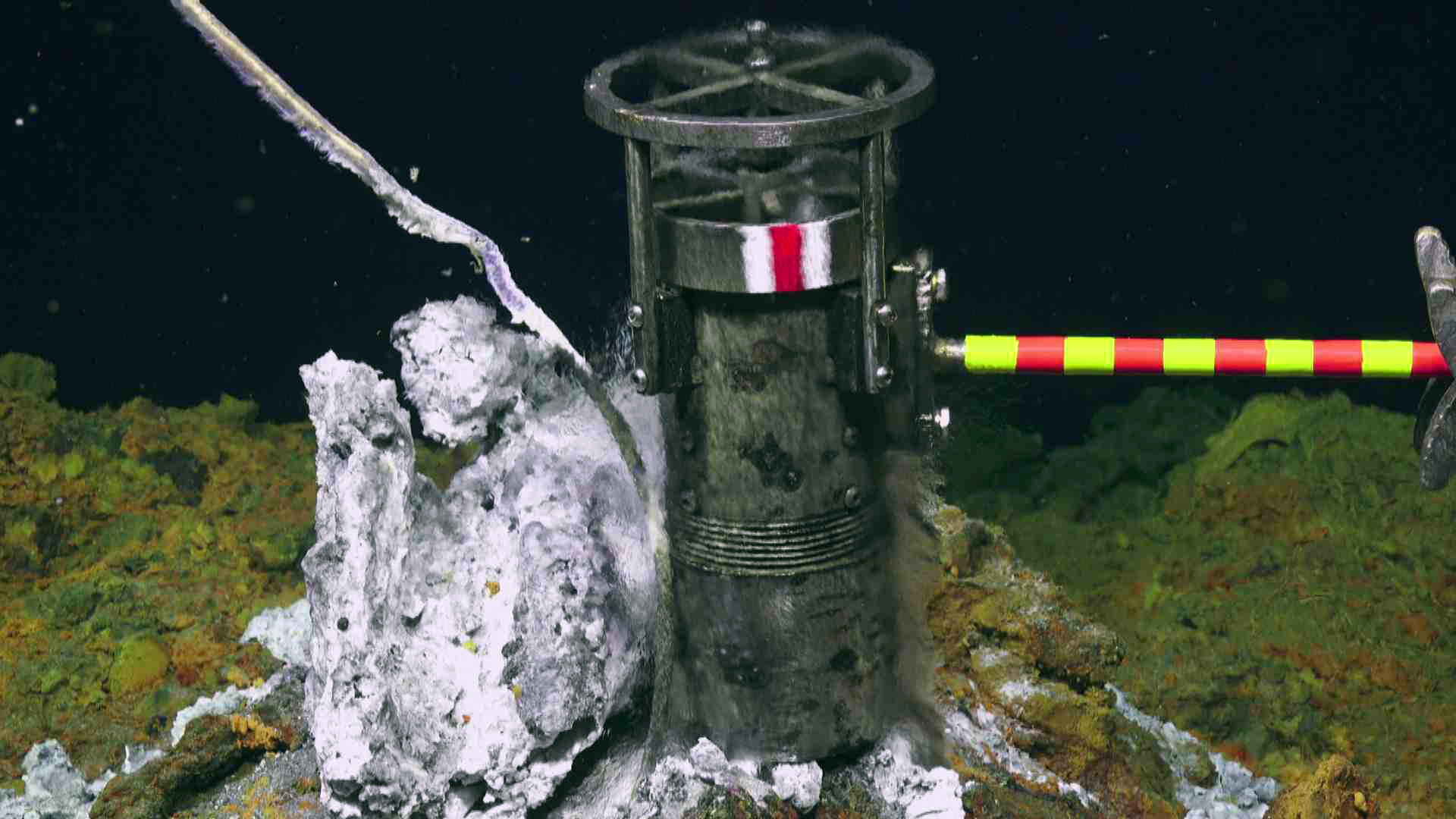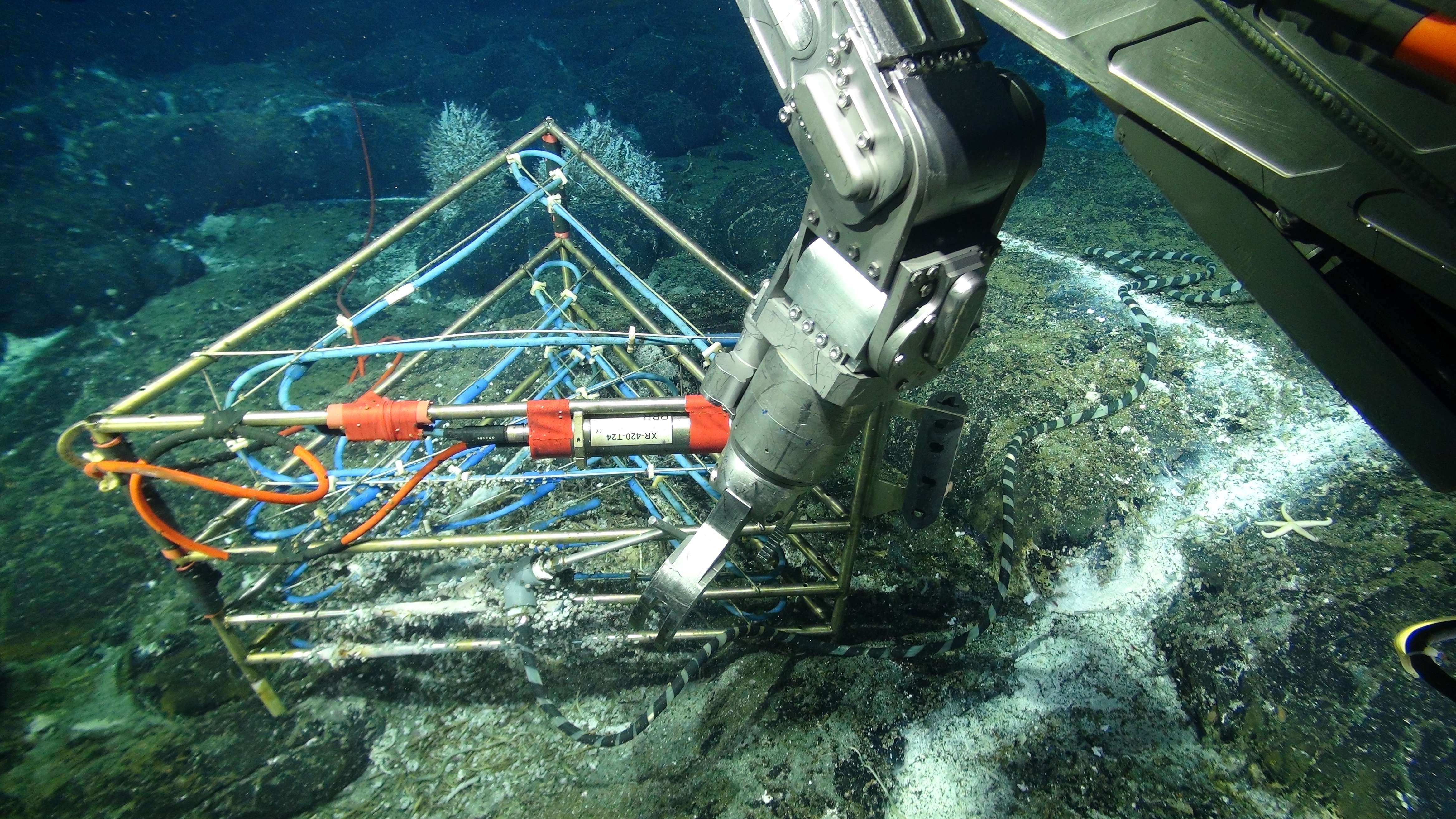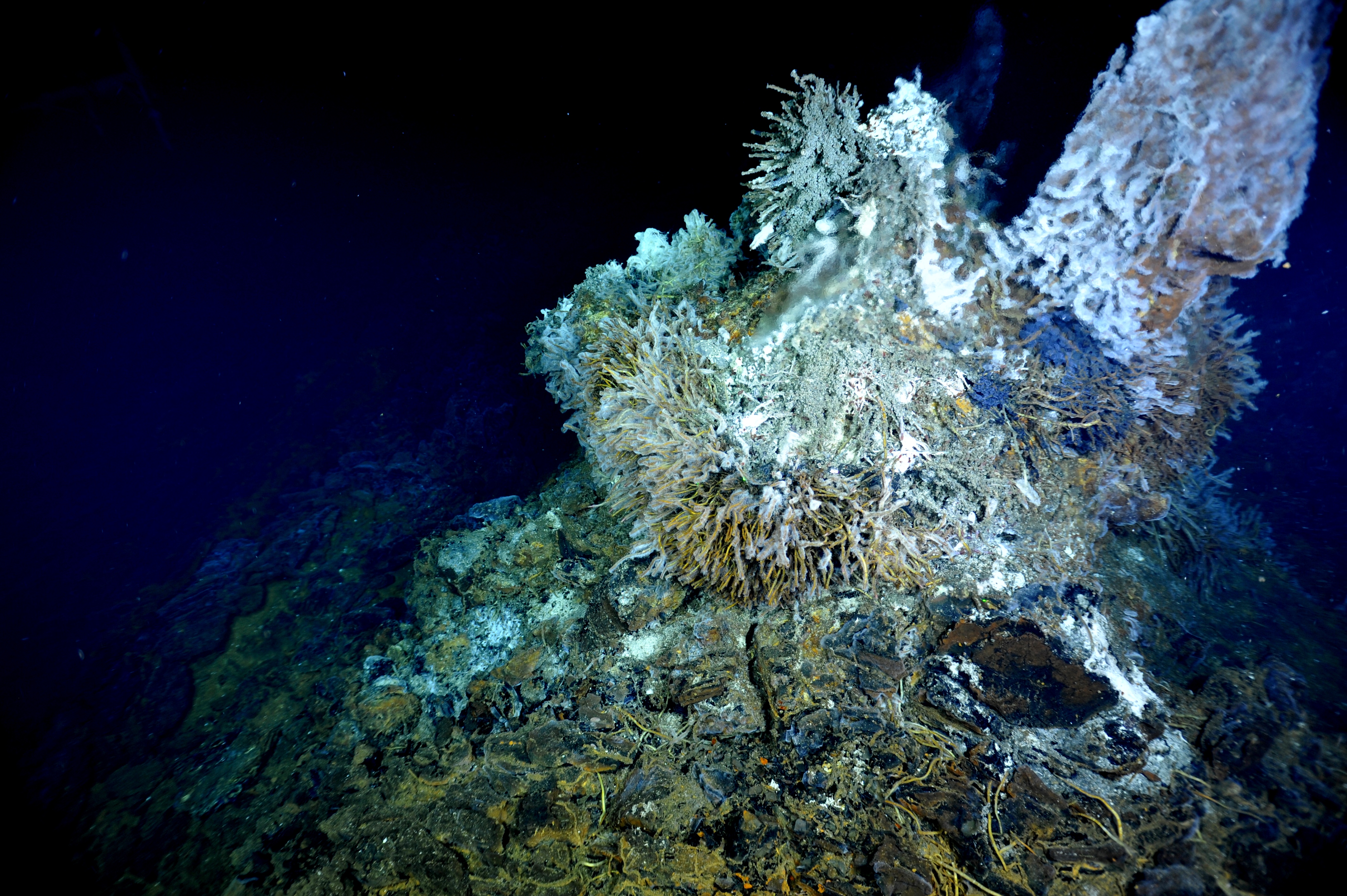Image Archive




























The and anhydrite-rich chimlet "Castle" rises from the seafloor. Credit: UW/NSF-OOI/WHOI:V20.

Organisms colonize the outer walls of the 16 m-tall hydrothermal edifice called El Guapo. The community structure changes with height above seafloor. Here, limpets, red scale worms and blue protists (ciliates) colonize the outer sulfide walls of the structure. Credit: UW/NSF-OOI/WHOI, V18.

A flow meter for hydrothermal vents is deployed at the small Diva chimney, held in the arm of Jason. Here, fluids are issuing the anhydrite-rich structure at ~ 290°C. The flow meter was designed by Leonid Germanovich, Clemson University. Credit: UW/NSF-OOI/WHOI, V18.

The UW-APL-built high definition camera lights up the 12-13 ft tall hot spring deposit called Mushroom, nearly 5000 ft beneath the oceans surface at the summit of Axial Seamount. Credit: UW/NSF-OOI/WHOI,V18.

LED lights on the high definition camera, built by the Applied Physics Laboratory at the University of Washington, light up a ~1 m tall, young black smoker chimney at the base of the actively venting Mushroom edifice on Axial Seamount (water depth ~1500 m). The image, taken with the ROV Jason, shows the camera being tested by UW engineers during VISIONS16. They were in the Operations Center, located 300 miles to the east at the School of Oceanography. Here, they were commanding/controlling the camera live through the terrestrial and submarine Internet as part of the NSF Cabled Array infrastructure. Credit: UW/NSF-OOI/WHOI; V16.

A new osmotic fluid sampler is about to be installed in a diffuse flow site hosting a 3D temperature array in the ASHES Hydrothermal Field on the summit of Axial Seamount. Each year, as part of the annual operations and maintenance cruise, a sampler is recovered and a new one installed. Onshore analyses of the entrapped fluids provide insights on the evolution of fluid chemistry in time, in response to changing environmental conditions e.g. earthquakes, temperature, microbial utilization of gases and different elements. Credit: UW/NSF-OOI/WHOI; V16.

The ROV Jason 'looks' at a hybrid underwater wet-mate connector that connects the high definition camera to a ~ 4 km long extension cabled attached to Primary Node PN3B at the summit of Axial Seamount. This connection provides a 10 Gbs communication path to the terrestrial Internet located ~300 miles to the east. White bacterial mats line fractures in the lava-covered seafloor where diffusely flowing fluids are exiting the seafloor. Credit: UW/NSF-OOI/WHOI; V16.

A 3D temperature (thermistor) array housing 24 sensors rests above a small diffuse flow site a few meters away from the actively venting black smoker edifice called Mushroom in the ASHES hydrothermal field on Axial Seamount. This cabled instrument was designed and built by G. Proskurowski, UW School of Oceanography. Limpets have colonized the frame and cable housing the thermistors. An osmotic fluid sampler is inserted into the diffuse flow site to obtain chemistry coregistered with temperature. Credit: UW/NSF-OOI/WHOI; V16.

A titanium isobaric gas-tight sampler (IGT) is used to sample fluids with dissolved gases in a high temperature vent on the El Gordo metal sulfide chimney located in the International District Hydrothermal Field at ~ 1500 m water depth on Axial Seamount. The base of the cabled RAS fluid sampler and microbial DNA sampler mooring is in the background. Credit: UW/NSF-OOI/WHOI; V16.

A Hydrothermal Vent Cap at the top of the actively venting chimney called ‘El Gordo’, traps high temperature hydrothermal fluid. An intake nozzle from the mass spectrometer allows measurement of gas chemistry in real-time, sending data at the speed of light back to shore. Another nozzle sucks in vent fluids for sampling and for filtering of microbial DNA: the samples fluids and DNA are recovered during annual Cabled Array maintenance cruises for follow-on shore-based analyses. Credit: UW/NSF-OOI/WHOI; Dive J2-912, V16.

A temperature probe (HOBO) installed by NOAA last year in the hydrothermal vent ‘Diva’ is now enclosed in the sulfate-rich, white mineral called anhydrite. The high temperature fluids at this site host very high concentrations of carbon dioxide being outgassed from the underlying magma chamber. Credit: UW/OOI-NSF/WHOI; Dive J2-912, V16.

A temperature-resistivity sensor, with its wand now embedded in a sulfate-rich chimney (white, right) sends real-time data to shore from the Escargot chimney, 5000 ft beneath the oceans' surface and >300 miles offshore. Resistivity is an analogue for fluid chlorinity. Numerous hydrothermal vents in the International District Hydrothermal Field at the summit of Axial Seamount are boiling. Credit. UW/OOI-NSF/WHOI; Dive J2-912, V16.

A digital still camera (left), mass spectrometer (middle) and hydrothermal fluid and microbial DNA sampler (right) document changes in animal life, gas and fluid chemistry, temperature, and chimney growth at the El Gordo vent site in the International District Hydrothermal Field at the summit of Axial Seamount - water depth is ~ 5000 ft (1500 m). Data are streaming live to shore 24/7. Credit: UW/OOI-NSF/WHOI, V16.

A digital still camera, mass spectrometer, and fluid and microbial DNA sampler installed at the El Gordo hydrothermal chimney, International District Hydrothermal Field, Axial Seamount. A small, 1-day old chimlet sprouts from the 280°C, gas-rich vent called Dive in the International District Hydrothermal Field. NSF-OOI/UW/ISS; Dive R1839; V15.

A small, 1-day old chimlet sprouts from the 280°C, gas-rich vent called Dive in the International District Hydrothermal Field. Credit: UW/NSF-OOI/CSSF; ROPOS Dive R1839; V15.

A huge rattail, ~ 5 feet in length, swims slowly in front of the ROV ROPOS near the International District Hydrothermal Field at a depth of 5000 ft beneath the ocean's surface. This area has a higher abundance of these fish than observed elsewhere in the caldera, perhaps because of the larger size of the vent field and hence food source. Credit: UW/NSF-OOI/CSSF; ROPOS Dive R1729; V15.

The RO ROPOS holds a 'IGT' gas tight bottle in the orifice of the 280°C chimney called Diva. The high temperature fluids exiting the seafloor at this anhydrite-rich (CaSO4) vent contain the highest carbon dioxide concentrations at Axial Seamount. Credit: NSF-OOI/UW/ISS; Dive R1836; V15.

An Osmotic fluid sampler is installed in a small diffuse flow site hosting abundant tubeworms, limpets, and palm worms in the ASHES hydrothermal fluid. When recovered next year, the fluids this sampler host will provide information on how vent fluid chemistry changes over time. The nozzle iis installed inside a triangular 3D thermistor array is Credit: UW/NSF-OOI/CSSF; ROPOS Dive R1835; V15.

During ROPOS Dive R1730, the UW-RCA high-definition video camera was tested successfully. The camera was installed in 2013 and 1-year later it worked extremely well. A test 3-D thermistor array (bottom right) that was installed last year rests on a diffuse flow site, covered in microbial filaments. To the left, a cabled 3-D thermistor array will replace the uncabled system. Credit: UW/NSF-OOI/CSSF; Dive ROPOS R1730; V14.

El Gordo, at International District, is a site for Regional Cabled Array instrumentation in 2014. Brown tubes are stressed tubeworms covered in filamentous bacteria. Credit: UW/NSF-OOI/CSSF; ROPOS Dive R1719; V14.

The anhydrite chimney 'Diva' visited with the ROV ROPOS during the VISIONS'14 program. This is an extremely CO2-rich vent with temperatures measured at 294°C (561°F) in July.

The top of the 16-m tall El Guapo edifice that emits boiling fluids. Credit: UW/NSF-OOI/CSSF; ROPOS Dive R1713; V14.

A novel gas-tight fluid sampler takes a sample of 271°C (~520°F) fluid venting from the Escargot chimney in the International District hydrothermal field on Axial Seamount. Credit: UW/NSF-OOI/CSSF; ROPOS Dive R1713; V14.

Beautiful blue ciliates (protists) line the base of the hydrothermal vent called El Gordo. Credit: UW/NSF-OOI/CSSF; ROPOS Dive R1713; V14

During Dive R1273, the 271°C venting orifice was visited at Escargot and a gas-tight fluid sample was taken. The srtucture is named after its morphology, which clearly resembles a snail. Photo Credit: NSF-OOI/UW/CSSF; Dive R1713; V14.

Filamentous bacteria coat the outer surfaces of the sulfide chimney called Castle in the International District Hydrothermal Field on the eastern side of the Axial Seamount caldera. Warm fluids emanate from a small vent beneath Castle, supporting the microbial communities.

Tube worms encased in dense mats of filmentous bacteria cover a portion of the Inferno black smoker in ASHES vent field.
- Anemone
- Animal
- Arthropod
- ASHES
- Axial
- Axial Base
- Axial Biology
- Axial Caldera
- Bacteria
- Basalt Lava
- BEP
- Biofouling
- biolgoy
- Biology
- Camds
- Camera
- Camhd
- Central Caldera
- Ciliates
- Cnidaria
- Coastal Biology
- Crab
- Deep Profiler Mooring
- Dive Highlights
- Eastern Caldera
- Echinoderms
- Endurance Array
- Engineering Team
- ENLIGHTEN 10
- Exploratorium
- Fish
- Geology
- HD Camera
- HPIES
- Hydrate Ridge
- Hydrates
- Hydrophone
- Hydrothermal Vents
- Illustration
- Inshore 80 Meters
- Instrument
- International District
- J-BOX
- Jason
- Jellyfish
- Junction Box
- K12
- Lava
- Mollusk
- Moorings
- Nodes
- Nudibranch
- Octopus
- OOI
- Oregon Offshore
- Oregon Offshore 600 m
- Oregon Shelf
- Oregon Slope Base
- People
- PN1B
- PN1D
- Polychaetes
- PPSDN
- Primary Node
- RASFL
- ROCLS
- ROPOS
- ROPOS Dives
- ROV Team
- RV Revelle
- RV Sikuliaq
- RV Thompson
- Salp
- Sample
- SC13
- Science Team
- Sea Cucumber
- Sea Star
- Sea Urchin
- Seafloor
- Seismometer
- Sensors
- Shallow Profiler Mooring
- Shark
- Shipboard
- Shore Station
- Slope Base
- Smoker
- Soft Coral
- Southern Hydrate Ridge
- Sponge
- Squid
- Students
- Students & Guest Participants
- Tmpsf
- Tubeworms
- VISIONS 11 Leg 1
- VISIONS 11 Leg 2
- VISIONS 11 Viewers
- VISIONS 13
- VISIONS 14
- VISIONS 15
- VISIONS 16
- VISIONS 17
- VISIONS 18
- VISIONS 20
- VISIONS 22
- VISIONS 23
- Visualization
